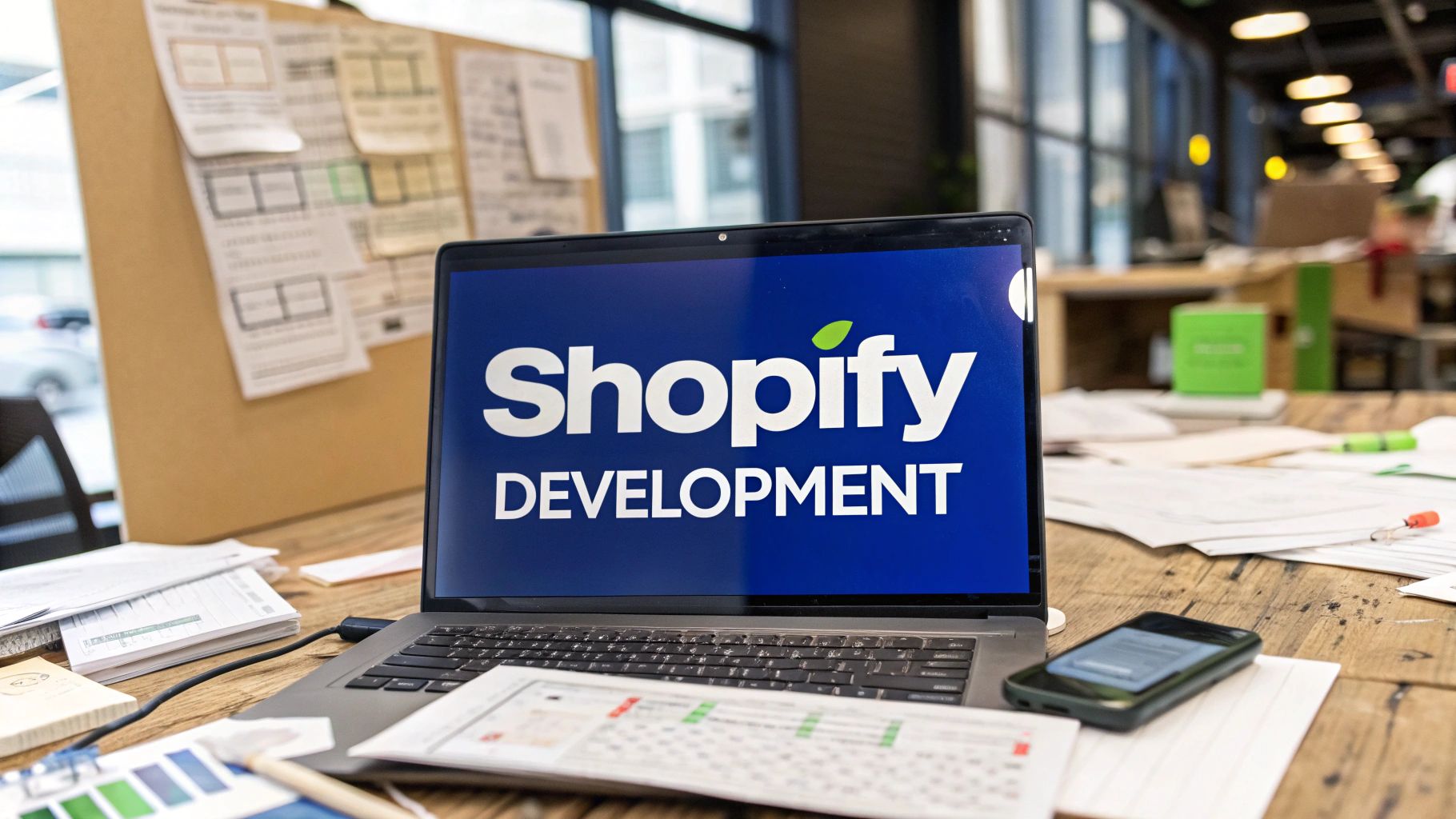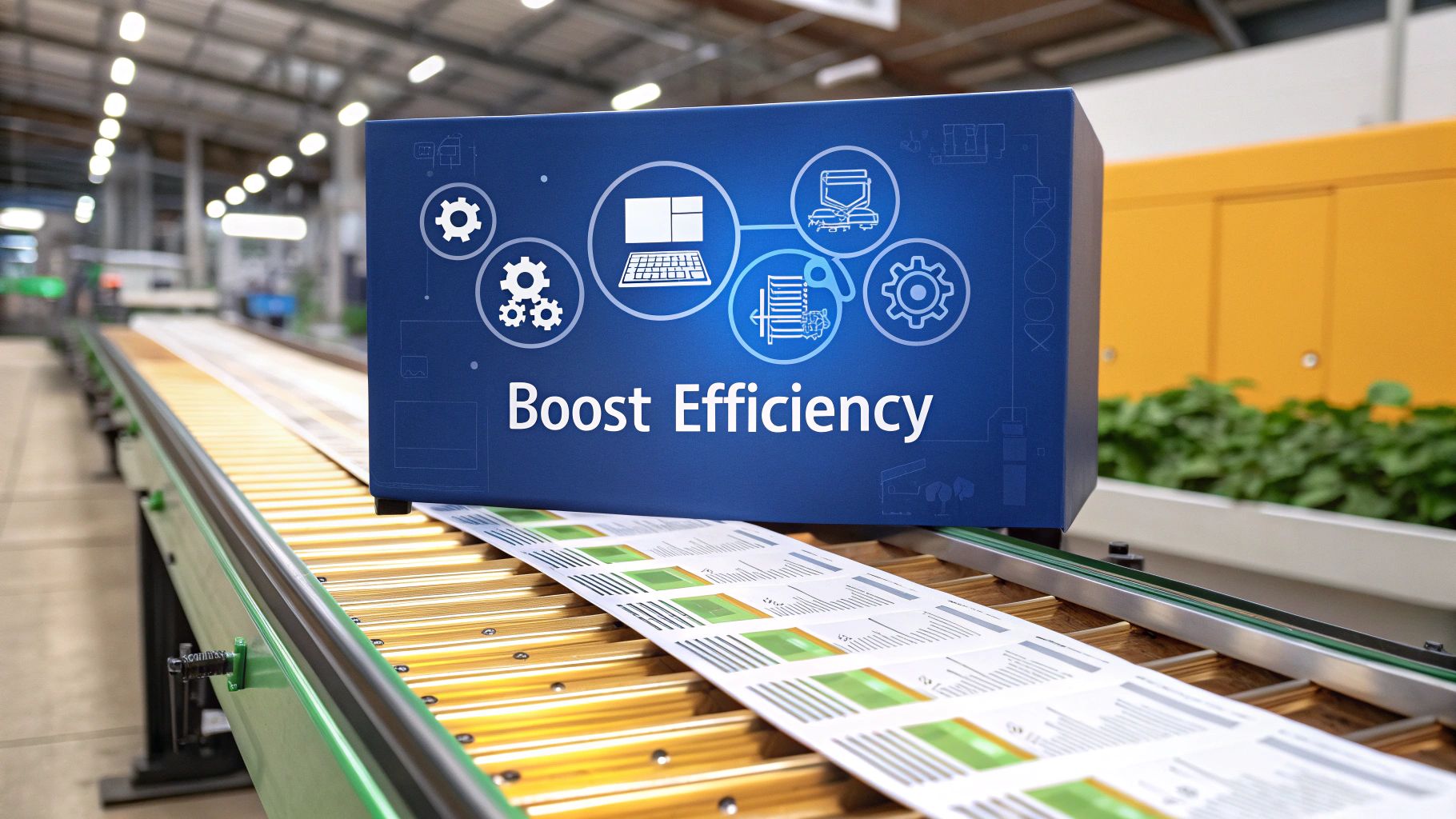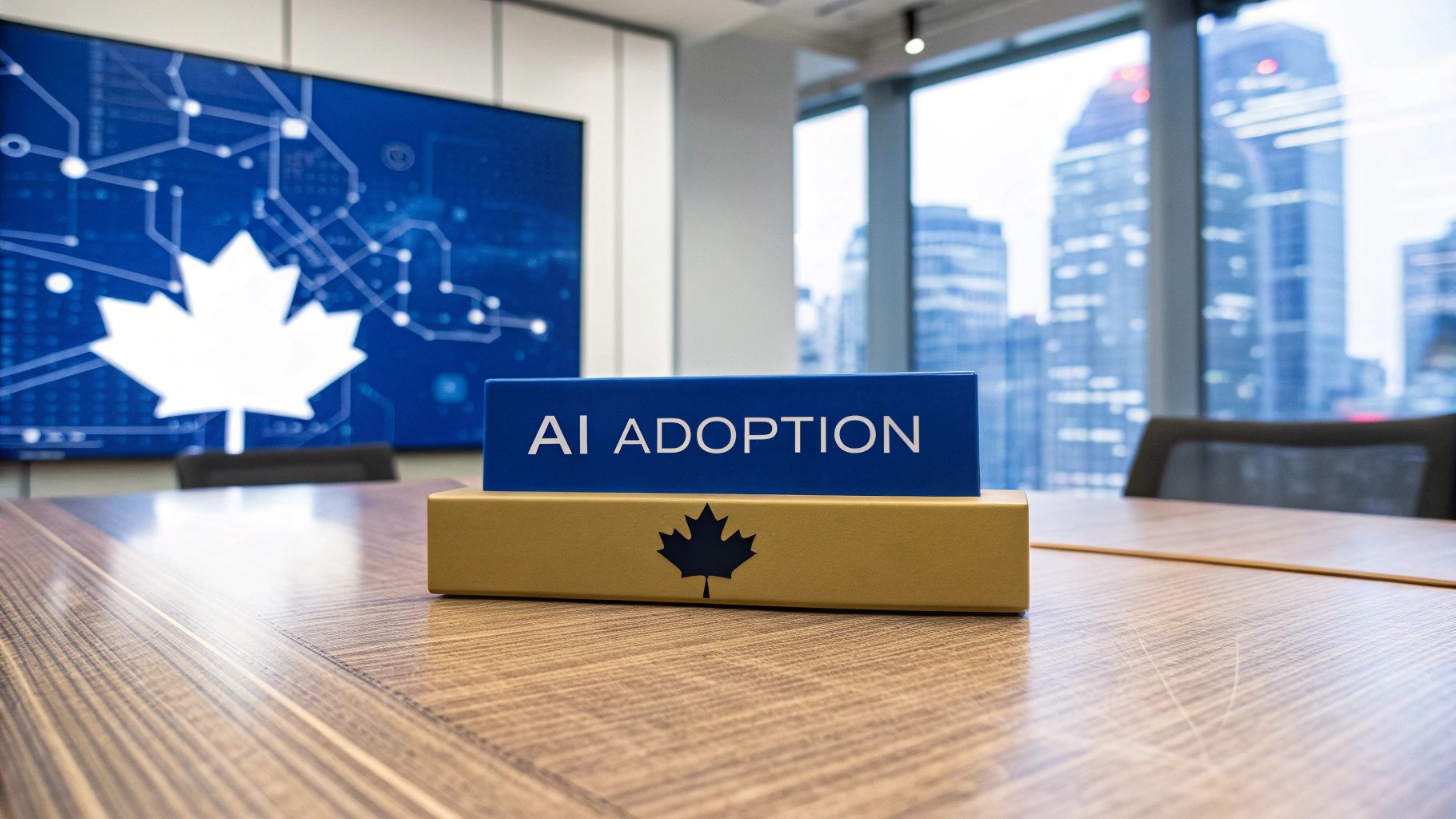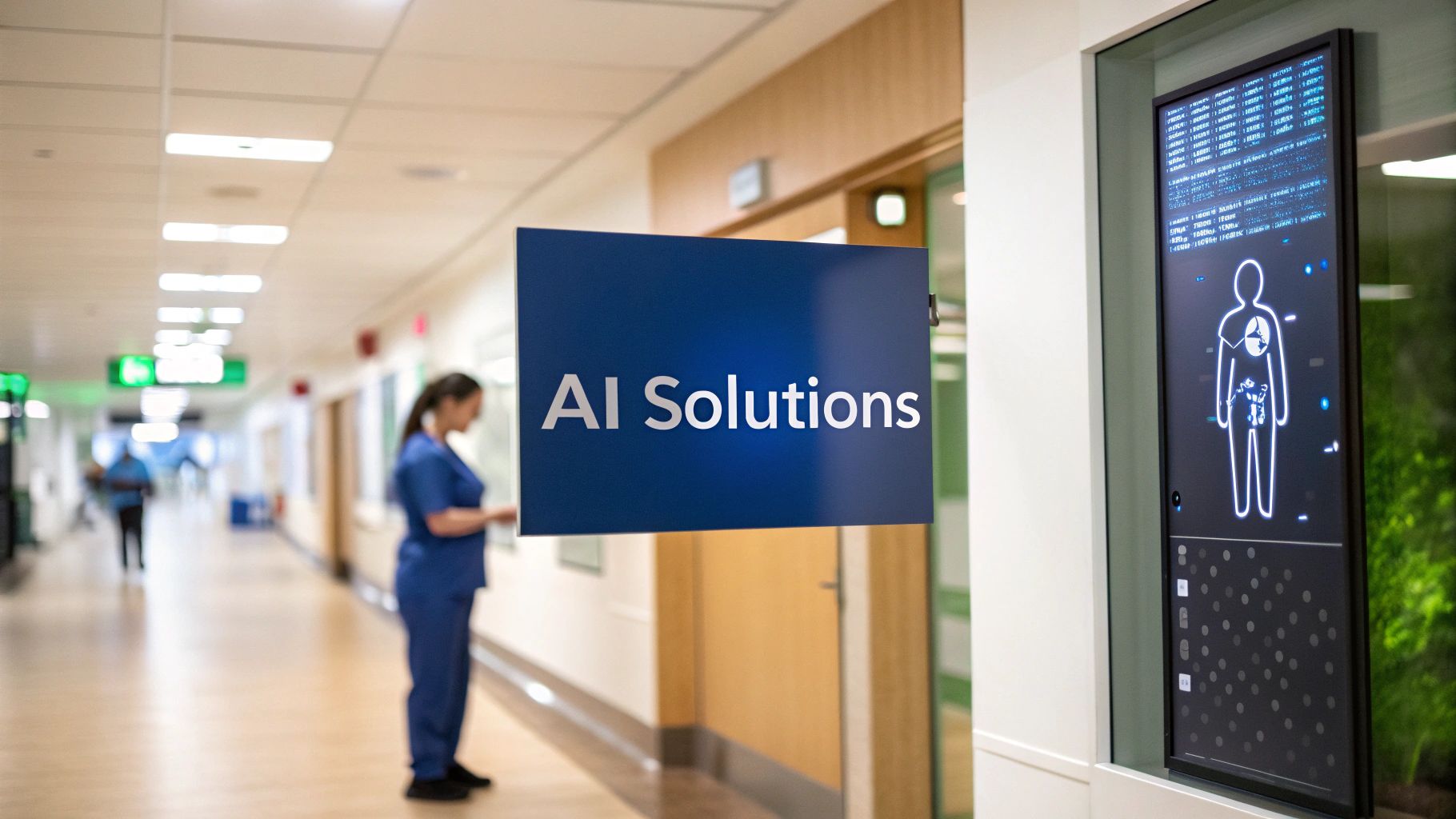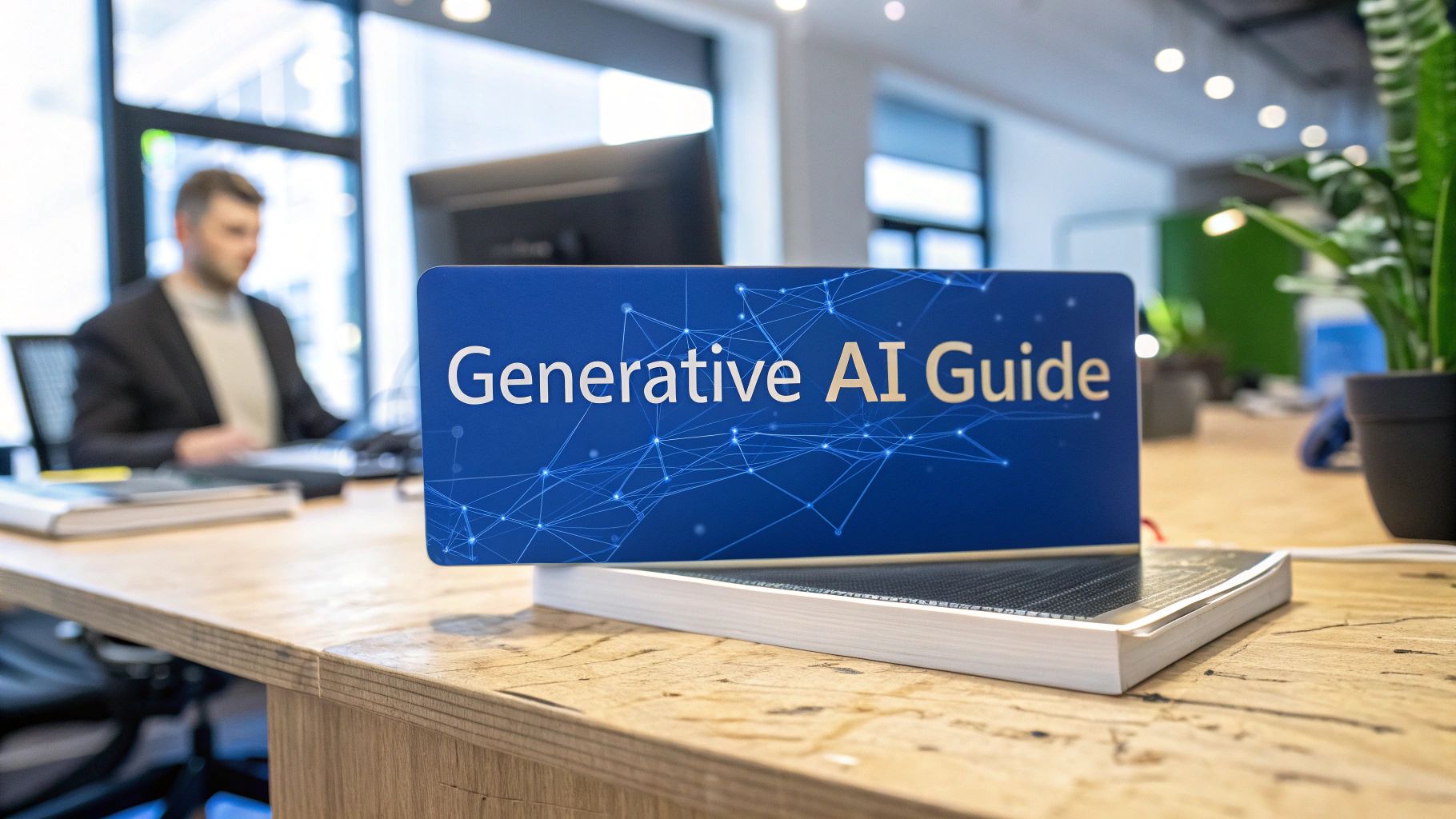Think of a standard Shopify theme as a beautiful, move-in-ready house in a new subdivision. It looks fantastic, and all the plumbing works; it gets the job done. But it’s not your house. The layout, the fixtures, the overall feel, it’s the same as your neighbour’s.
Shopify development, on the other hand, is like hiring an architect to design and build a custom home from the ground up, perfectly suited to your family’s needs.
So, What Is Shopify Development Really?

At its core, Shopify development involves going beyond the built-in theme editor to create a truly unique ecommerce experience. It’s about writing code to mould every aspect of your online store, from the way it looks and feels (the front-end) to how it handles orders and inventory (the back-end).
The whole point is to build a digital storefront that doesn’t just look like your brand but works like your business.
It’s More Than Just Drag-And-Drop
Shopify’s editor is a great tool for making quick visual tweaks. But for businesses with specific needs or ambitious goals, it’s just the starting point. Real development work picks up where the theme editor leaves off, solving problems that a template simply can’t.
- A Truly Custom User Journey: You can meticulously design the path a customer takes on your site, making it as smooth and intuitive as possible from the moment they land on your homepage to the final click at checkout.
- One-of-a-Kind Features: Ever wanted a custom product builder, a “members only” section, or a complex subscription model? That’s what development is for. It brings those big ideas to life.
- Deep System Integration: This is where things get really powerful. You can connect your store directly with crucial business software, like your inventory system, customer relationship management (CRM) platform, or third-party logistics (3PL) provider, creating seamless, automated workflows.
Shopify development isn’t just about making things look pretty. It’s a strategic move to build a real competitive edge. When your store operates exactly the way your business needs it to, you boost efficiency, make customers happier, and ultimately see better conversion rates.
The numbers don’t lie. Shopify stores processed a staggering $235.9 billion in gross merchandise volume (GMV) worldwide in 2023 alone. For Canadian businesses, a platform this robust offers a solid foundation for growth.
Choosing custom development means you can scale your business without being boxed in by the limitations of a pre-built theme. For any merchant who wants to stand out and operate at peak efficiency, it’s a critical part of the playbook. To see the bigger picture, you can dig into these expert tactics for success in Shopify web development. You may also find our own guide on the core aspects of AI-driven Shopify development services helpful.
Standard Shopify Setup vs Custom Shopify Development
So, what’s the real difference between sticking with a theme and going custom? This table breaks it down.
| Feature | Standard Shopify (Theme-based) | Custom Shopify Development |
|---|---|---|
| User Experience | Pre-defined layout with limited customization. Functional but often generic. | Fully bespoke journey designed around your specific customer and brand. |
| Functionality | Limited to what the theme and App Store apps offer. | Nearly limitless. If you can dream it, a developer can probably build it. |
| Performance | It can be slowed down by heavy apps and unoptimized code. | Optimized for speed from the ground up, leading to better conversions. |
| Brand Identity | Your brand fits into the theme’s constraints. | The store is built to be a perfect reflection of your brand. |
| Upfront Cost | Low. Typically, the cost of the theme $0 – $400. | Higher. Involves investment in professional development services. |
| Scalability | It may become restrictive as your business grows and needs become more complex. | Built to grow with your business, accommodating future needs and integrations. |
While a standard theme is an excellent and affordable starting point for many, custom development is the path for businesses that are serious about creating a distinct, high-performing ecommerce machine.
The Three Pillars Of Shopify Development

When we talk about Shopify development, it’s not just one single activity. It’s really a combination of three core areas that work together. I like to think of them as the architecture, the custom features, and the central nervous system of your online store.
Each pillar has its own job, but they’re all interconnected. Grasping how they fit together is the secret to building an ecommerce business that doesn’t just look the part, but runs like a well-oiled machine behind the scenes.
Pillar 1: Theme Development
This is all about what your customers see and interact with. Theme development is the art and science of crafting the visual storefront, the layout, the design, and the overall feel of your shop. It’s far more than just picking a colour scheme from a dropdown menu.
A Shopify developer dives deep into code here, using Liquid (Shopify’s unique templating language), HTML, CSS, and JavaScript. They’re either building a theme from the ground up or taking an existing one and bending it to their will, ensuring it perfectly mirrors a brand’s vision and serves its customers’ needs.
Great theme development delivers:
- A True Brand Experience: Your store should feel like your brand, not a slightly modified template that thousands of others are using.
- A Seamless Customer Journey: It’s all about making it incredibly easy for shoppers to find what they want and check out, eliminating any potential frustration.
- Blazing-Fast, Responsive Performance: The site has to look fantastic and load instantly on any device, whether it’s a giant desktop monitor or a smartphone.
Simply put, theme development is where your brand’s story becomes a beautiful, functional, and high-converting digital storefront. It’s your chance to make an unforgettable first impression.
Pillar 2: App Development
If the theme is the storefront, then custom apps are the unique tools and specialized features inside. While the Shopify App Store has a solution for almost everything, sometimes your business has a problem so specific that an off-the-shelf app just won’t cut it. That’s when custom app development becomes your secret weapon.
This is where a developer builds a private application that bolts new, proprietary functionality right onto your store. You can create a tool to solve almost any operational headache or create a unique customer experience that sets you apart.
A few real-world examples include:
- A highly detailed product customizer, letting customers design their perfect item from scratch.
- A complex, tiered loyalty program built around your specific business model.
- A sophisticated wholesale portal with unique pricing and ordering rules for your B2B clients.
The best part? When you build a custom app, you own it. You’re not at the mercy of a third-party developer’s pricing changes or feature updates. You have total control over a crucial piece of your business.
Pillar 3: API Integrations
The third pillar is the one your customers will never see, but it might just be the most powerful. API (Application Programming Interface) integrations are the invisible threads that connect your Shopify store to all the other software that runs your business.
Think of an API as a universal translator, allowing completely different software systems to talk to each other seamlessly. Developers use Shopify’s robust APIs to build these connections, automating workflows that would otherwise be a massive time sink.
This is the plumbing and wiring of your entire operation. For a growing business, this part of Shopify development is non-negotiable. For example, when an order comes in, a well-built API integration can instantly:
- Update stock levels in your warehouse system.
- Add the customer to your CRM.
- Push the order details to your shipping provider.
All of this happens in the blink of an eye, with zero manual input. This is what transforms a simple online store into a scalable, automated ecommerce powerhouse.
Your Shopify Development Project Roadmap
Starting a custom Shopify development project can feel like a massive undertaking. But when you break it down into a clear, logical process, it becomes far less intimidating. Think of it like building a house: you wouldn’t dream of putting up walls without a solid foundation and a detailed blueprint. This roadmap lays out the essential phases that take an idea from a sketch on a napkin to a fully functioning, high-performing ecommerce store.
Each stage builds on the one before it, making sure nothing gets missed and the final product actually delivers on your business goals. Sticking to a structured approach like this is often the difference between a smooth project and one plagued by delays and costly revisions.
Phase 1: Discovery And Strategy
This is where it all begins: the foundation. Before anyone writes a single line of code, we need to get to the core of why you’re building this. This phase is all about deep-dive conversations between you and your development partner to nail down your business goals, figure out exactly who your target audience is, and map out the technical nuts and bolts.
Here’s what really happens in this phase:
- Goal Setting: We define what a “win” looks like for you. Is it boosting conversion rates by 15%? Automating a painful manual workflow? Or creating a customer experience that no one else in your industry can match?
- Audience Analysis: We get inside your customers’ heads. Who are they, really? What do they need and expect from your online store?
- Technical Audit: We take a look under the hood of your existing systems. This helps us plan for crucial integrations, like connecting your new store to your inventory management or CRM software.
Honestly, this strategic planning is the most critical part of the entire project. A solid strategy stops scope creep in its tracks, gets everyone on the same page, and ensures the final product solves real business problems, it’s not just a pretty facelift.
You only have to look at the success of Canadian businesses on the platform to see why a good plan matters. Shopify now powers around 107,000 stores across Canada, making it a dominant force in the country’s ecommerce scene. That growth is fuelled by its seamless integration with local payment gateways and shipping carriers, a perfect example of how a well-planned platform can meet specific market needs. You can find more stats on Shopify’s Canadian presence on sumtracker.com.
Phase 2: Design And UX/UI
With a clear strategy locked in, the focus shifts to how the store will look, feel, and function for your customers. This is all about user experience (UX) and user interface (UI) design. First, the UX designer will create wireframes: basically, the architectural blueprints for your site. They map out the entire customer journey to make sure the flow is intuitive and logical.
Once that structure is approved, the UI designer brings it to life. They apply your brand’s visual identity, from colours and fonts to imagery, creating a design that’s both compelling and beautiful. The whole point is to make shopping effortless and enjoyable, guiding customers smoothly from the homepage all the way to checkout.
Phase 3: Development And Coding
This is where the magic happens. The visual designs and strategic plans are handed over to the developers, who turn them into a real, working website. It’s a two-part process: front-end developers build everything the customer sees and interacts with (using languages like HTML, CSS, and JavaScript), while back-end developers handle the server-side logic, build any custom apps, and manage API integrations.
This infographic gives a simple overview of how the core development process flows.

As you can see, it starts with the visual theme work, moves into connecting functional apps and systems, and wraps up with a thorough testing and launch sequence.
Phase 4: Testing And Quality Assurance
Before you even think about going live, the site has to go through its paces. This is the Quality Assurance (QA) phase. The QA team meticulously combs through every single part of the store, hunting for bugs and glitches. They test on different browsers, devices, and screen sizes to make sure every user has a flawless experience. From the product pages to the checkout process, everything has to work exactly as planned.
Phase 5: Launch And Post-Launch Support
Once all the tests are passed and you’ve given the final green light, it’s launch day. The development team deploys the new site, making it live for the world to see. But the job isn’t done. Post-launch support is absolutely crucial. This involves monitoring performance, quickly fixing any unexpected issues that pop up, and providing ongoing maintenance to keep your store secure and running smoothly.
High-Impact Areas For Customization

When you decide to go the custom Shopify development route, the sheer number of options can feel a bit overwhelming. But here’s the thing: not all customizations are created equal. To really get the most bang for your buck, you want to focus your efforts and your budget on the areas that make a real difference to your customer experience, your day-to-day operations, and, ultimately, your bottom line.
Think of your development budget like fuel for a car. You could sprinkle it around a bit everywhere, or you could pour it right into the engine to get some serious horsepower. The areas below are your ecommerce engine, and investing here is what drives real growth.
Crafting A Unique User Experience
A generic storefront gets you generic results. It’s as simple as that. The single most powerful area you can customize is the user experience (UX), the art and science of making your store feel intuitive, enjoyable, and dead simple to use. A great UX doesn’t just look pretty; it smoothly guides a shopper from the “just browsing” phase right through to checkout.
This is about going way beyond the standard theme layout. A good developer can build a shopping journey from the ground up that speaks directly to your specific customers.
For instance, they might build a slick, one-page checkout that slashes cart abandonment rates. Or maybe they create a personalized shopping feed that shows customers products based on what they’ve looked at before, which can do wonders for your average order value. A thoughtfully designed UX makes your customers feel like you just get them.
Driving Performance Optimization
In ecommerce, speed is money. Seriously. Even a one-second delay in your page loading can send your conversion rates plummeting. Performance optimization is the nitty-gritty technical work of making your website as fast and responsive as it can possibly be. It’s a huge deal for keeping customers happy and for getting on Google’s good side.
A developer worth their salt will zero in on your store’s Core Web Vitals, which are the key metrics Google uses to judge a site’s technical health. This usually involves a few key moves:
- Optimizing Images: Shrinking image file sizes without making them look pixelated so they load in a flash.
- Minifying Code: Stripping out all the unnecessary spaces and characters from the site’s code (CSS and JavaScript) to make it leaner.
- Leveraging Caching: Storing parts of your site in a visitor’s browser so it doesn’t have to reload everything from scratch every time they come back.
A zippy site keeps people from bouncing and helps you rank higher in search results. Both of those things lead directly to more sales.
Integrating Crucial Business Systems
The best Shopify stores aren’t islands. They’re the command centre of a much larger business ecosystem, all connected through smart API integrations. This is where custom development can automate huge chunks of your workload and save you from hours of mind-numbing manual entry.
Picture this: when a customer places an order, your Shopify store instantly “talks” to your other business tools. It automatically updates your Enterprise Resource Planning (ERP) system, adjusts inventory levels in your warehouse management software, and drops the new customer’s info into your CRM. This kind of automation all but eliminates human error and frees up your team to focus on growing the business.
Integrating your business systems transforms your Shopify store from a simple sales channel into the command centre for your entire operation. It’s the key to scaling efficiently without getting bogged down by manual processes.
Building Custom Functionality For New Revenue
Sometimes, your big idea requires a feature that you just can’t find in a standard theme or an off-the-shelf app. This is where building custom functionality comes in, unlocking brand-new ways to make money and serve your customers. For these kinds of advanced features, developers often get into creating custom Liquid sections to build exactly what’s needed right into the theme.
These features are built from scratch, just for you. Think about launching a subscription box to lock in recurring revenue, setting up a private wholesale portal with special pricing for your B2B clients, or even developing a complex product builder that lets customers design an item from the ground up. This is the kind of bespoke functionality that can set you miles apart from the competition.
Shopify Development Best Practices For Success
Building a custom Shopify store is an exciting journey, but a beautiful design is only one piece of the puzzle. To create an ecommerce machine that’s fast, dependable, and ready for whatever comes next, you have to stick to some core principles during the Shopify development process. Think of these as the blueprints for a store that not only works well today but can grow with you tomorrow.
Following these guidelines is the difference between building a robust digital asset and a fragile storefront that cracks under the pressure of a minor update. They cover everything from how your customers interact with your site to its technical backbone.
Adopt A Mobile-First Design Philosophy
Let’s face it: the way people shop has completely changed. Most of your customers are on their phones, not sitting at a desk. Mobile commerce isn’t just a trend anymore; it’s the norm. That’s why designing for the smallest screen first and then scaling up a mobile-first approach is essential.
This strategy forces you to focus on what truly matters, resulting in a clean, intuitive, and quick-loading experience for the majority of your traffic. When the mobile experience is effortless, conversions just happen. For any project aiming for top-tier results, layering in Shopify conversion rate optimization tactics on top of a solid mobile foundation is a game-changer.
Write Clean And Maintainable Code
Every impressive Shopify store is powered by clean, well-organized code. It’s like the wiring and plumbing of your business. If it’s a chaotic mess, any future repairs or upgrades become a painful, expensive, and risky ordeal.
Writing maintainable code is all about discipline. It means using logical naming for files and functions, leaving comments to explain tricky bits, and sticking to Shopify’s established standards. This effort pays for itself many times over, making future updates, bug fixes, or even handing the project to a new developer a smooth process. It’s what allows your store to evolve with your business, not hold it back.
A commitment to clean code is a commitment to the long-term health and scalability of your ecommerce business. It saves you from costly technical debt and ensures your store remains agile and easy to manage for years to come.
Build SEO-Friendliness Into The Core
Search Engine Optimization (SEO) can’t be a sprinkle-on-top ingredient you add at the end. It has to be woven into the very fabric of your theme from the very first line of code. A developer with a sharp eye for SEO will build a store that search engines can crawl and index efficiently, giving you a huge head start in the race to rank for your keywords.
This involves some key technical moves:
- Implementing correct heading structures (H1, H2, H3) to give your content a clear, logical hierarchy.
- Ensuring fast page load speeds, which is a massive ranking factor for Google.
- Generate a clean URL structure that’s easy for both people and search engine bots to understand.
- Adding structured data (Schema markup) helps Google instantly recognize your product details, reviews, and pricing.
Prioritise Accessibility For All Users
At the end of the day, a truly great website is one that anyone can use, regardless of their abilities. Accessibility (A11y) is all about designing and building your site so that people with disabilities, like visual or motor impairments, can browse and buy from you without friction.
This isn’t just about doing the right thing; it’s smart business. An accessible site opens your doors to a wider audience and, frankly, improves the user experience for every single visitor. This kind of thoughtful planning is a hallmark of excellent ecommerce development.
How To Choose Your Shopify Development Partner
Picking the right team for your Shopify development project is a make-or-break decision. Honestly, the success of your entire online store can ride on their skill, communication, and dependability. This isn’t just about hiring someone who can code; you’re looking for a strategic partner who truly gets your business vision.
The whole process means you’ve got to do your homework. It’s about separating the capable coders from the genuine ecommerce strategists who can elevate your business. A great partner won’t just build what you ask for; they’ll push back, challenge your assumptions, and offer smarter solutions based on what they’ve seen work.
Evaluating Their Portfolio And Past Work
First things first, get your hands on their portfolio. You’re looking for a solid history of successful Shopify stores that aren’t just pretty but are also doing some heavy lifting under the hood. Don’t just skim the homepages, really dig in. Click around, add something to the cart, and see how the site feels as a customer.
Look for variety in their past projects. Have they worked with businesses like yours, whether in size or industry? That kind of relevant experience is gold. Beyond the portfolio itself, hunt for client testimonials and reviews that give you a feel for their process and the results they delivered.
A slick portfolio shows they have the technical chops, but glowing testimonials prove they can manage a project, communicate well, and actually deliver what they promise. You need to see evidence of both.
Assessing Technical And Strategic Expertise
A beautiful portfolio is a great start, but you have to peek behind the curtain to confirm their technical skills. Any Shopify developer or agency worth their salt needs to be an expert in a few key areas. Figuring out their technical depth is vital, much like understanding the basics in any good custom software development guide.
Make sure they have a firm grasp of:
- Shopify Liquid: This is Shopify’s own templating language. If they don’t know it inside and out, they can’t build a proper theme.
- Shopify APIs: Their ability to connect your store to other essential tools like inventory or marketing systems all comes down to how well they know the APIs.
- Modern Front-End Frameworks: Skills in JavaScript and its related frameworks are non-negotiable for creating the fast, responsive experiences customers expect today.
But technical prowess is only half the battle. The best partners are also sharp ecommerce strategists. They should be able to talk confidently about conversion rate optimization, SEO, and mapping out the ideal customer journey. You want a team that worries about your sales numbers, not just the lines of code. The best way to test this? Come to the conversation with smart questions that probe their business sense and problem-solving skills.
Frequently Asked Questions About Shopify Development
Diving into Shopify development can feel a bit overwhelming, especially if it’s your first time. Business owners often have a lot of the same questions, so I’ve put together some straightforward answers to the ones we hear most often.
Think of this as your go-to guide for getting a handle on the practical side of building a custom Shopify store.
What’s the Real Cost of Custom Shopify Development?
This is the big one, and the honest-to-goodness answer is: it depends entirely on what you need. The price tag is directly linked to the scope and complexity of the work. For example, some simple theme customizations could be a few thousand dollars.
On the other hand, if you’re looking at a complete, custom-built store with its own unique app and complex integrations with other business software, you could be looking at a range from $25,000 to well over $100,000. The most important thing is to get a detailed quote based on a crystal-clear list of what you want built. That’s how you avoid any nasty surprises down the road.
Can I Just Do the Shopify Development Myself?
While Shopify’s theme editor is great for making basic tweaks, real development is a whole different beast. It demands a strong understanding of coding languages like Liquid, HTML, CSS, and JavaScript.
If you need major design changes, want to speed up your site, or require special features, bringing in a professional is your best bet. It’s the only way to guarantee a high-quality, secure, and reliable result that protects both your investment and your brand’s reputation.
How Long Does a Shopify Development Project Usually Take?
Just like the cost, the timeline can vary quite a bit. A smaller project, like making a few key theme adjustments, might wrap up in about 4 to 6 weeks. But a full-blown store built from the ground up, with lots of custom features and integrations, can easily take 3 to 6 months, sometimes longer.
The final timeline really boils down to two things: how complex the project is and how quickly you can provide feedback and approvals. Clear communication and quick decisions from your end can make a huge difference.
Is Custom Development Actually Better Than a Premium Theme?
The best choice really hinges on your business goals and where you’re at right now. Premium themes are fantastic for startups or businesses with pretty standard needs. They offer a professional look and get you up and running fast without a massive upfront cost.
Custom development, however, is the way to go for established brands that need to stand out from the competition. It’s the right move if you’re looking for:
- A one-of-a-kind user experience that’s built for conversion.
- Specific features that you just can’t find in an off-the-shelf app.
- Seamless integration with your other business systems to make things run smoothly.
Basically, you go custom when you’ve outgrown the pre-built options and need a website perfectly tailored to how your business actually works.
Ready to build a Shopify store that stands out and scales with your business? The team at Cleffex Digital Ltd specializes in creating custom ecommerce solutions that drive growth. Let’s talk about your project today.

